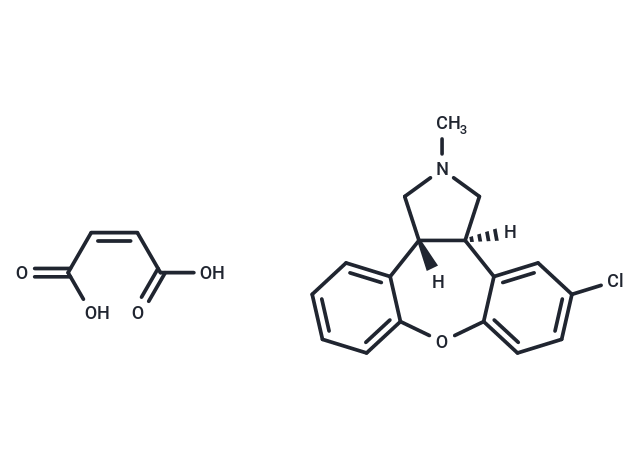Shopping Cart
- Remove All
 Your shopping cart is currently empty
Your shopping cart is currently empty
Asenapine Maleate (Org 5222 maleate) is a second generation (atypical) antipsychotic agent that is taken sublingually and used in the treatment of schizophrenia and manic or mixed episodes associated with bipolar 1 disorder. Asenapine is associated with a low rate of transient and mild serum aminotransferase elevations during therapy but has not been linked to instances of clinically apparent acute liver injury.

| Pack Size | Price | Availability | Quantity |
|---|---|---|---|
| 5 mg | $30 | In Stock | |
| 10 mg | $47 | In Stock | |
| 25 mg | $73 | In Stock | |
| 50 mg | $97 | In Stock | |
| 100 mg | $137 | In Stock | |
| 200 mg | $237 | In Stock | |
| 500 mg | $392 | In Stock | |
| 1 mL x 10 mM (in DMSO) | $50 | In Stock |
| Description | Asenapine Maleate (Org 5222 maleate) is a second generation (atypical) antipsychotic agent that is taken sublingually and used in the treatment of schizophrenia and manic or mixed episodes associated with bipolar 1 disorder. Asenapine is associated with a low rate of transient and mild serum aminotransferase elevations during therapy but has not been linked to instances of clinically apparent acute liver injury. |
| Targets&IC50 | 5-HT7:9.94(pKi), 5-HT2A:10.15(pKi), D 4 Receptor:1.1 nM (Ki), D3 receptor:0.42 nM (Ki), 5-HT2C:10.46(pKi), 5-HT2B:9.75(pKi), D 2 Receptor:1.3 nM (Ki), sPLA2:2.5 nM (Ki), 5-HT6:9.6(pKi) |
| In vitro | Asenapine (0.01 mg/kg, i.v.) preferentially increased dopamine outflow in the shell compared to the nucleus accumbens (NAc) core, with no difference observed at a higher dosage (0.05 mg/kg, i.v.). Asenapine significantly enhanced the response to NMDA in pyramidal cells within the medial prefrontal cortex. In freely moving rats, Asenapine (0.05-0.2 mg/kg, subcutaneous injection) induced dose-dependent conditioned avoidance response (CAR) inhibition (without recording escape failures) and did not induce cataleptic fainting. Moreover, Asenapine (0.05-0.2 mg/kg, subcutaneous injection) increased dopamine outflow in both the medial prefrontal cortex and the nucleus accumbens in rats. |
| In vivo | Asenapine demonstrates a higher affinity for 5-HT 2C, 5-HT 2A, 5-HT 2B, 5-HT 7, 5-HT 6, alpha2B, and D3 receptors compared to its affinity for D2 receptors, indicating a closer interaction with these targets at therapeutic doses. Asenapine is an effective antagonist for a range of receptors, including 5-HT 1A (7.4), 5-HT 1B (8.1), 5-HT 2A (9.0), 5-HT 2B (9.3), 5-HT 2C (9.0), 5-HT 6 (8.0), 5-HT 7 (8.5), D2 (9.1), D3 (9.1), alpha2A (7.3), alpha2B (8.3), alpha2C (6.8), and H 1 receptors (8.4), as indicated by their respective pKB values. |
| Kinase Assay | In vitro kinase activity: GST-FAK in vitro kinase activity is measured and compared to His-tagged FAK 411–686 using the K-LISA screening kit and poly(Glu:Tyr) (4:1) copolymer as a substrate immobilized on microtiter plates. IC50 values are determined with various concentrations of test compounds in a buffer containing 50 μM ATP and 10 mM MnCl2, 50 mM HEPES (pH 7.5), 25 mM NaCl, 0.01% BSA, and 0.1 mM Na orthovanadate for 5 min at room temperature. Serial diluted compounds are tested in triplicate. Substrate phosphorylation is measured using horseradish peroxidase-conjugated anti-pTyr antibodies with spetrophotometric color quantitation. IC50 values are determined using the Hill-Slope Model. Kinase selectivity profiling is performed by using the KinaseProfiler service. |
| Synonyms | Org 5222 maleate, Org 5222 |
| Molecular Weight | 401.84 |
| Formula | C21H20ClNO5 |
| Cas No. | 85650-56-2 |
| Smiles | OC(=O)\C=C/C(O)=O.[H][C@@]12CN(C)C[C@@]1([H])c1cc(Cl)ccc1Oc1ccccc21 |
| Relative Density. | no data available |
| Storage | Powder: -20°C for 3 years | In solvent: -80°C for 1 year | Shipping with blue ice/Shipping at ambient temperature. | |||||||||||||||||||||||||||||||||||
| Solubility Information | H2O: < 1 mg/mL (insoluble or slightly soluble) DMSO: 60 mg/mL (149.31 mM), Sonication is recommended. Ethanol: < 1 mg/mL (insoluble or slightly soluble) | |||||||||||||||||||||||||||||||||||
Solution Preparation Table | ||||||||||||||||||||||||||||||||||||
DMSO
| ||||||||||||||||||||||||||||||||||||

Copyright © 2015-2025 TargetMol Chemicals Inc. All Rights Reserved.